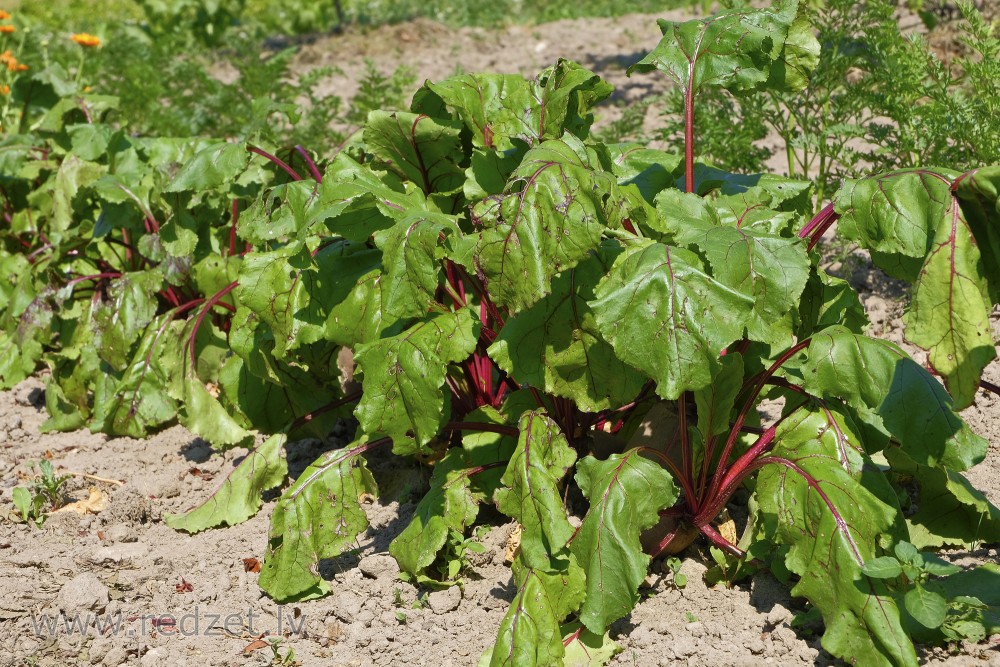Beta vulgaris (beet)
Beta vulgaris (beet) is a plant which is included in Betoideae subfamily in the Amaranthaceae family. It is the economically most important crop of the large order Caryophyllales. It has several cultivar groups: the sugar beet, of greatest importance to produce table sugar; the root vegetable known as the beetroot or garden beet; the leaf vegetable known as chard or spinach beet; and mangelwurzel, which is a fodder crop. Three subspecies are typically recognised. All cultivars fall into the subspecies Beta vulgaris subsp. vulgaris. The wild ancestor of the cultivated beets is the sea beet (Beta vulgaris subsp. maritima).
Scientific classification
Kingdom: Plantae
Order: Caryophyllales
Family: Amaranthaceae
Genus: Beta
Species: B. vulgaris
Description
Beta vulgaris is an herbaceous biennial or, rarely, perennial plant up to 120 cm (rarely 200 cm) height; cultivated forms are mostly biennial. The roots of cultivated forms are dark red, white, or yellow and moderately to strongly swollen and fleshy (subsp. vulgaris); or brown, fibrous, sometimes swollen and woody in the wild subspecies. The stems grow erect or, in the wild forms, often procumbent; they are simple or branched in the upper part, and their surface is ribbed and striate. The basal leaves have a long petiole (which may be thickened and red, white, or yellow in some cultivars). The simple leaf blade is oblanceolate to heart-shaped, dark green to dark red, slightly fleshy, usually with a prominent midrib, with entire or undulate margin, 5–20 cm long on wild plants (often much larger in cultivated plants). The upper leaves are smaller, their blades are rhombic to narrowly lanceolate.
The flowers are produced in dense spike-like, basally interrupted inflorescences. Very small flowers sit in one- to three- (rarely eight-) flowered glomerules in the axils of short bracts or in the upper half of the inflorescence without bracts. The hermaphrodite flowers are urn-shaped, green or tinged reddish, and consist of five basally connate perianth segments (tepals), 3-5 × 2–3 mm, 5 stamens, and a semi-inferior ovary with 2-3 stigmas. The perianths of neighbouring flowers are often fused. Flowers are wind-pollinated.
In fruit, the glomerules of flowers form connate hard clusters. The fruit (utricle) is enclosed by the leathery and incurved perianth, and is immersed in the swollen, hardened perianth base. The horizontal seed is lenticular, 2–3 mm, with a red-brown, shiny seed coat. The seed contains an annular embryo and copious perisperm (feeding tissue).
There are 18 chromosomes found in 2 sets, which makes beets diploid. Using chromosome number notation, 2n = 18.
Uses
Food
Spinach beet leaves are eaten as a pot herb. Young leaves of the garden beet are sometimes used similarly. The midribs of Swiss chard are eaten boiled while the whole leaf blades are eaten as spinach beet.
In some parts of Africa, the whole leaf blades are usually prepared with the midribs as one dish.
The leaves and stems of young plants are steamed briefly and eaten as a vegetable; older leaves and stems are stir-fried and have a flavour resembling taro leaves.
The usually deep-red roots of garden beet can be baked, boiled, or steamed, and often served hot as a cooked vegetable or cold as a salad vegetable. They are also pickled. Raw beets are added to salads. A large proportion of the commercial production is processed into boiled and sterilised beets or into pickles. In Eastern Europe beet soup, such as cold borsch, is a popular dish. Yellow-coloured garden beets are grown on a very small scale for home consumption.
The consumption of beets causes pink urine in some people.
Jews traditionally eat beet on Rosh Hashana (New Year). Its Aramaic name סלקא sounds like the word for "remove" or "depart"; it is eaten with a prayer "that our enemies be removed".
Nutrition
In a 100 gram amount, beets supply 43 Calories, contain 88% water, 10% carbohydrates, about 2% protein and have a minute amount of fat (table). The only micronutrients of significant content are folate (27% of the Daily Value, DV) and manganese (16% DV).
Traditional medicine
The roots and leaves of the beet have been used in traditional medicine to treat a wide variety of ailments. Ancient Romans used beetroot as a treatment for fevers and constipation, amongst other ailments. Apicius in De re coquinaria gives five recipes for soups to be given as a laxative, three of which feature the root of beet. Platina recommended taking beetroot with garlic to nullify the effects of 'garlic-breath'.
Beet greens and Swiss chard are both considered high oxalate foods which are implicated in the formation of kidney stones.
en.wikipedia.org




